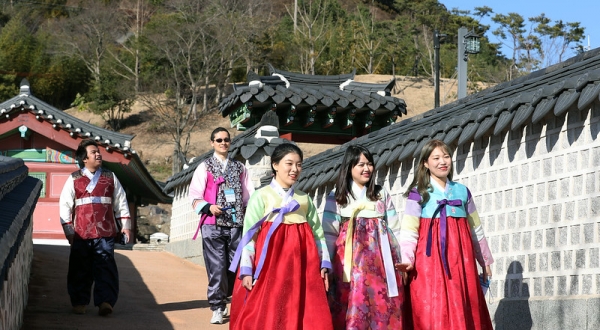
The Cultural Heritage Administration (CHA) has designated as National Intangible Cultural Heritage the culture of wearing the traditional attire, or Hanbok saenghwal (lifestyle).
The CHA on July 20 announced this decision, saying the lifestyle symbolizes the Korean people's identity and values and embodies traditional lifestyle and knowledge.
Hanbok saenghwal refers to a series of cultural practices that encompass the entire experience of making, wearing and enjoying the traditional attire in accordance with specific etiquette and formalities depending on occasion such as ceremonies, rituals, traditional holidays or recreational events. Hanbok consists of a jeogori (top) and either a chima (skirt) or baji (trousers) with otgoreum (ribbon knotted to close the top), completing its distinct look.
Earlier in March, the CHA said it would name the cultural heritage item "Hanbok wearing" but decided on Hanbok saenghwal, saying the former term might mislead people into thinking it refers only to wearing Hanbok.
Koreans have worn Hanbok since ancient times as evidenced by relics and records such as tomb murals from the Goguryeo Dynasty (37 B.C.- A.D. 668) and historical documents from China. The Three Kingdoms era (57 B.C.-A.D. 668) was when the two-piece, top-and-bottom structure of the clothing was fully established.
Hanbok's structure kept evolving based on the nation's distinct clothing culture, and the prototype of domestic clothing was built during the Joseon Dynasty (1392-1910).
The term "Hanbok" is assumed to have been used to differentiate domestic apparel from its foreign counterpart with the arrival of Western culture after Korea in 1876 opened its ports to the world. When and by whom the term was first used remains unknown.
The use of Hanbok has greatly declined in daily life but the culture of wearing it has endured. The attire is worn to show courtesy on special occasions such as Seollal (Lunar New Year), Chuseok (Korean Thanksgiving), weddings and ancestral rituals.
"Likewise, Hanbok is more than just a piece of clothing to Koreans, it is an important custom through which people have practiced courtesy and wished for each family member's good health and well-being," the CHA said. "This is why Hanbok surely is a valuable intangible asset."
Meanwhile, the cultural authority does not recognize a specific group or person as a transmitter of the designation, saying Hanbok saenghwal is a cultural tradition practiced by all Koreans on the Korean Peninsula,
As of last month, 14 items designated National Intangible Cultural Heritage had no specific group or person recognized as a transmitter of their designations: "Arirang" (traditional folk song); jeda (tea making); ssireum (traditional wrestling); haenyeo (female divers); kimchi damgeugi (making of kimchi); jeyeom(traditional salt production); ondol (underfloor heating system); jang damgeugi (sauce and paste making); traditional fishing eosal (fishing trap); hwalssogi (traditional archery); insam jaebae and yakyong munhwa(cultivation of ginseng and its medicinal applications); makgeolli bitki (making and sharing the milky rice wine makgeolli); tteok mandeulgi (making and sharing rice cakes); and getbol eoro (tidal flat harvesting).


